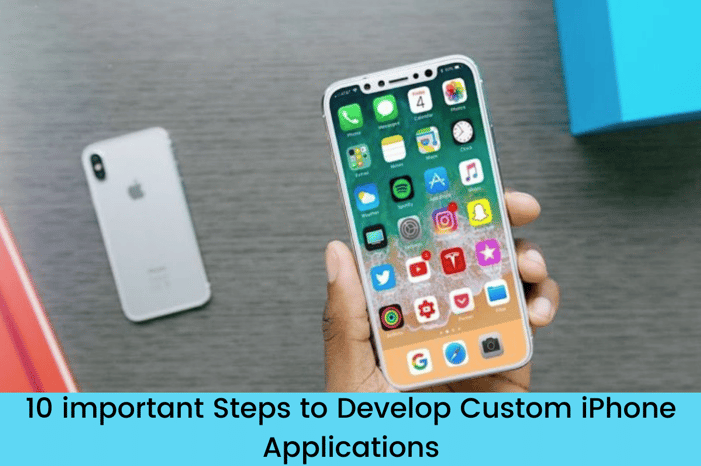
Apple, the Cupertino giant, is developing some of the best devices in the world. A majority of people from different parts of the world are obsessed with iPhones. Therefore, various businesses and users are looking forward to developing iPhone applications to reach potential customers.
You just came across an exciting and unique idea, but how you will be able to convert your idea into reality. In this digital era, before you start developing an iPhone application, you must be familiar with some essential steps that will be useful in the iPhone App Development.
Without further ado, let’s get started:
1. Sketch up for idea or vision
Every app starts with an idea or vision. It doesn’t require to be extraordinary. You only need a plan.
Mention your idea through sketch using pen and paper. The main purpose is to make this idea work. You need to mention all the features of the app before starting its development.
You don’t have to take the help of tools and software to present your idea. Just describe it using a pen and paper. Start sketching the app along with all the list of features and check if the idea looks good in life.
The most important thing is to divide the features of the app into two groups: Should Have and Nice to Haves. They Should Have are the features without which your app doesn’t work and Nice to Haves are features that are awesome but not essential.
While you create your app, the most important thing is to make it simple & effective. This is also known as Minimum Viable Product (MVP), and it’s the basic, most straightforward version of any app. When you concentrate on the most important things, you increase the development process and make your app more flexible against setbacks.
2. Know your competitors
Conducting market research and knowing your competitors is one of the most crucial steps for any app which is not done by the majority of developers.
In order to make sure that your app idea is feasible, you must answer the following questions:
- What are the alternative apps and competitors in the current market?
- Who will be the target audience of the app? What are their needs and expectations from the app?
- How much will you charge for the app? Which business model you will apply to the app?
3. Risk Assessment
Project development is not complete until one doesn’t evaluate all the risks involved in it. Risk evaluation is essential to check all the potential risks and their equivalent measures.
There are a lot of issues that might occur during iOS App development. If all the problems are determined before it happens, then the development team will be prepared to face it.
4. Requirement Gathering
This is the most important step for developers as they have to think from the client as well as the user’s perspective. They have to identify all the tools and technologies that will be needed to build an app.
Here, it is crucial to meet the expectations of both client and users and includes all the tools and technologies required to fulfill their needs and desires.
5. Create a Prototype of your app
It’s excellent to create a prototype before you develop an app. A prototype is a rough sketch of your app’s layout, user interfaces (UIs) and it’s flow.
Mockup of an app doesn’t consist of the following things:
- Perfect Position of UI Elements
- Fine-grained UI Elements
- Complex color schemes and other effects
A prototype displays how your app looks like, without focusing on other details of the app. It follows a functional approach rather than an aesthetic approach to your app’s design.
6. Planning
The whole planning process includes figuring out all the tasks that will be carried out by the developers and the process they will follow to complete the tasks.
More importantly, to make your project work break it into small and practically feasible parts. Listing out all the resources as well as tasks, and creating a schedule are some of the most crucial things while planning your project.
7. Create Graphic Design of your app
Now, as you are on the right track, it’s essential to create a graphic design of your app. It consists of pixel-perfect visual details, images, graphic effects, animations, and motions that are present in the app.
You can either perform this task yourself using a graphic design template, or you can hire a graphic designer.
If you are not familiar with designing, then we highly recommend allocating this task to a professional graphic designer. Because he/she has spent a majority of time in practicing and designing different web and mobile application projects.
8. Develop your app
Now, as you have completed the basic layout of the entire system, developing an app becomes much more manageable. You have already made the mockups and done with the graphic design of the app.
We recommend you to develop your app using Xcode and Swift. The Xcode IDE consists of a project manager, code editor, integrated documentation, debugging tools, and an Interface Builder.
Swift is a general-purpose, multi-paradigm, and compiled programming language that is useful to develop iOS, macOS, iPadOS, tvOS, and watchOS apps.
Please note that Xcode only runs on macOS; therefore, you will require access to a mac to create iOS apps.
We suggest you use Xcode 11 as it allows you to integrate the latest features into the app with ease, such as dark mode. Apart from this, it is recommended to use Swift 5, as it comes with a lot of benefits.
9. Testing
After the development is completed, this is one of the most critical steps for an iOS app development company.
In the testing phase, all the aspects of the app should be tested to check its functionality and performance. This includes error tracking in the code, checking whether all the features and integrations are working properly or not and whether the app meets the desired quality standards or not.
An app should be thoroughly tested during the entire coding phase to come up with the best solution with the least or no errors.
10. Releasing your app in the App Store
As soon as you have completed all the above steps, your app is ready to launch your app in the app store.
Follow the process given below to publish your app in the app store:
- Sign in to your Apple App store connect account.
- Click on + sign and submit your app with all the essential details.
- Upload your app to the Apple app review board.
- Now, open the organizer in the Xcode and choose the app and then choose to build and then click on distribute the app.
- Apple will review the app as per the App Store Review Guidelines.
- If your app is perfect, then it will be released in the App Store.
- Now, users can download & install the app.
To ensure that your app doesn’t get rejected, you should stick to the apple app store guidelines from the beginning till the end. Moreover, you should try to make it completely error-free as resolving errors after the app is submitted can be time-consuming and might result in the app to receive negative reviews on the App Store.
So, there were 10 Important Steps that all the Developers Should Consider while developing custom iPhone Applications.
